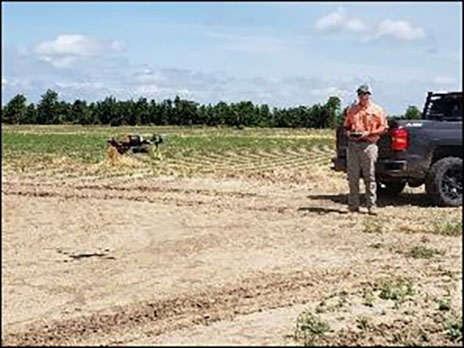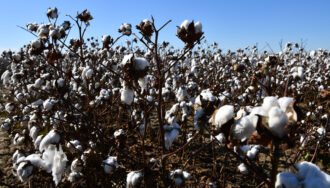LAKE PROVIDENCE, Louisiana – Corn and cotton crop producer Nolan Parker is taking to the skies to decrease nitrogen runoff from commodity farms along the Mississippi River.
The young farmer, who is a Federal Aviation Administration (FAA) certified remote pilot and works routinely with unmanned aerial systems (UAS), combined drone technology with variable rate nitrogen mapping sensors to more closely measure crop nitrogen needs. Currently, farmers use ground-based precision agriculture equipment to map a crop’s nitrogen needs and apply the fertilizer accordingly. Parker feels UAS technology is more efficient.
“Farmers aim to be environmental stewards and cooperate with environmental programs aimed at increasing nitrogen-use efficiency,” said Parker. “However, we are still applying nitrogen rates that are, most likely, higher than optimal. I feel unmanned aerial technologies are a more efficient means of sensing early crop nitrogen status. The goal is to not only save input costs for farmers, but to reduce nitrogen runoff in our waterways.”
Parker received a Southern Sustainable Agriculture Research and Education (SSARE) Producer Grant to compare a fixed wing system and a quad copter, both equipped with a multispectral camera (which captures images across various wavelengths), and analyzing those images using a host of vegetation indices to measure overall plant health. The idea was to determine at which growth stage corn and cotton needed nitrogen, thereby more accurately targeting nitrogen application.
The study was conducted on the family farm in northeast Louisiana, just a few miles from the Mississippi River in an agricultural area dominated by large swaths of corn, cotton and soybean fields.

During the two-year study, Parker found that the fixed wing flight platform performed more efficiently than the quad copter, covering more field area and allowing for more targeted spectral imaging. The vegetation indices that most accurately measured overall plant health and nitrogen needs were those that focused on red-edge spectral bands (as opposed to blue, green, red or near-infrared), such as Simplified Canopy Chlorophyll Content Index (SCCCI) and FENDVI (Fox Enhanced Nitrogen Difference Vegetation Index).
Combined with a variable rate nitrogen application plan on the tested corn and cotton fields, Parker found that farmers may reduce nitrogen input without sacrificing a significant reduction in yield. The variable rate nitrogen prescription Parker applied was developed using the Vari-Rite® mapping tool developed by MSU precision agriculture specialist Amelia Fox in 2012 while doing similar research. Fox is Parker’s graduate advisor in the Department of Plant and Soil Sciences.
“Basically, we are trusting the plant to tell us what it wants and what it needs, when it needs it,” said Parker, “so that we are optimizing nitrogen use efficiency to get the highest yields without overapplying the fertilizer. Ultimately this saves farmers money and protects our natural resources.”
Two 20-acre cotton plots were studied in the project’s first year; while a 40-acre corn plot and an 80-acre cotton plot were studied in the project’s second year. For each test plot, the crops received starter nitrogen applications. Then at the crops’ early growth stages (between V4-V8 for corn and pinhead square for cotton), variable rate nitrogen applications were applied based on the sensing data collected from the unmanned aerial systems, and compared to the recommended fixed nitrogen rate via the Vari-Rite tool. Yields were then calculated based on the rates applied.
Parker found that for cotton, optimal yields were achieved at a variable nitrogen rate application much lower than the recommended fixed rate. For example, in one cotton plot, data showed that half of the nitrogen application (15 pounds per acre) was only needed to achieve similar yields (1,288 pounds per acre) compared to the fixed nitrogen rate (30 pounds per acre for 1,283 pounds per ace in yield). Data showed that yields decreased beyond that point even with increased variable nitrogen rate applications.
For the corn test plots, data suggested that corn maximizes its fertilizer needs at the V-8 growth stage. Data from one test plot demonstrated that corn yields peaked at 226 bushels per acre, which was achieved with a variable rate nitrogen application ranging from 99 pounds per acre to 108 pounds per acre. Corn yields began decreasing as variable rate nitrogen applications reached 110 pounds per ace to 120 pounds per acre. The fixed nitrogen rate was 119 pounds per acre with yields of 223 bushels per acre.
“That data suggests that even with the increased nitrogen applications, the cotton and corn plants had received all they needed. Any higher applications were ineffective in increasing yields,” said Parker.
Parker thinks that the key to using the unmanned aerial systems to map out a more accurate canopy sensing for nitrogen status actually lies in the plants themselves.
“Corn and cotton have a distinctive canopy architecture that aids in estimating nitrogen status, and coupling that with faster sensing speeds that the unmanned aerial systems, especially the fixed wing, can employ just improves the accuracy of the data that is collected,” said Parker.
The young farmer is excited about the results of the study, which he considers novel, but admits that much work still needs to be done in the field to either affordably get the technology into the hands of farmers, or provide a way to transfer the data to existing equipment, such as tractors, for immediate nitrogen application.
“The way farmers do it now is that they collect the data from precision agriculture technology directly from the tractor and apply nitrogen simultaneously while sensing data is being collected,” said Parker. “There is some time delay with unmanned aerial systems. How quickly can we collect sensing data and get that nitrogen on the ground in a timely manner?”
Parker even envisions the development of a tool that farmers can use to optimize the data collected from unmanned aerial systems and develop the best nitrogen application prescription for their particular on-farm situation.
“This type of technology, unmanned aerial systems, is becoming more important in areas of stewardship and being more responsible in managing agricultural lands,” said Parker. “We need to be in a position to develop tools that make it affordable for farmers to use the technology, and provide training to help them become more comfortable with the technology so that they are more willing to adopt.”
